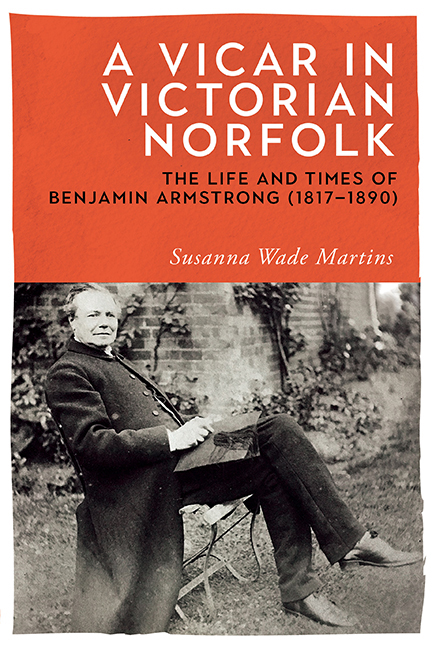Book contents
- Frontmatter
- Contents
- List of Illustrations
- Acknowledgements
- Foreword
- Author's Note
- Map
- Introduction
- I The Early Years
- 1 Early Life
- 2 The Move to Dereham
- II Public Life
- 3 The Norfolk Clergy
- 4 Church Life
- 5 The Building Legacy
- 6 Schools
- 7 Town Life
- III Family and Friends
- 8 Family Life
- 9 Friends
- IV Later Life
- 10 The Later Years
- 11 Armstrong: A Man of His Time
- Bibliography
- Timeline
- Index
3 - The Norfolk Clergy
Published online by Cambridge University Press: 14 August 2020
- Frontmatter
- Contents
- List of Illustrations
- Acknowledgements
- Foreword
- Author's Note
- Map
- Introduction
- I The Early Years
- 1 Early Life
- 2 The Move to Dereham
- II Public Life
- 3 The Norfolk Clergy
- 4 Church Life
- 5 The Building Legacy
- 6 Schools
- 7 Town Life
- III Family and Friends
- 8 Family Life
- 9 Friends
- IV Later Life
- 10 The Later Years
- 11 Armstrong: A Man of His Time
- Bibliography
- Timeline
- Index
Summary
I love the church too well to pretend that they [the clergy] reach the standards of their high calling or worthy of their vocation. There are good and true amongst them, but I am dealing with majorities and not exceptions.
Let England's priests have their due: they are a faulty set in some respects, but only of common flesh and blood, like us all; but the land would be badly off without them: Britain would miss her church, if that church fell. God save it! God also reform it!
So wrote two observers of the clergy, one a Norfolk woman and the other the daughter of a Yorkshire clergyman. To these opinions can be added that of Armstrong:
It is often thought that the life of a country parson is one of perfect ease and freedom from care … having no enemies and beloved by all.… Such are the characteristics of the class described by novelists … but I am certain that no pastor of a country town desirous of doing the Church's work ought to expect this enviable freedom from trial. (4/9/55)
Who were the Norfolk clergy?
Aged 33 when he was appointed to Dereham, Armstrong was one of a large group of young men entering the ministry at the time. Reporting in 1835 on the age of the clergy, the Ecclesiastical Commission noted that while the largest number of incumbents in the Norwich diocese (fifty) were in the age group 60–65, there was also a significant group of younger men, with forty-five being under 30 and forty-three being between 31 and 35. The years 1800–30 saw a huge expansion of Oxford and Cambridge universities, creating a pool of potential graduate clergymen and producing throughout Victoria's reign about 600 ordinands a year. As a result, nationally by 1840 the majority of parsons were aged under 45. For the first time since the Reformation the church was served by a majority of young and enthusiastic clergy. To quote Charlotte Brontë describing in the first paragraph of Shirley the situation in the 1840s, ‘They [the curates] are young enough to be very active and ought to be doing a great deal of good.’ By the 1850s the profession was therefore predominantly a young one.
- Type
- Chapter
- Information
- A Vicar in Victorian NorfolkThe Life and Times of Benjamin Armstrong (1817–1890), pp. 67 - 90Publisher: Boydell & BrewerPrint publication year: 2018

